Have you ever made milk soap? Did you add the lye directly to the milk? Ewww! What’s that smell?
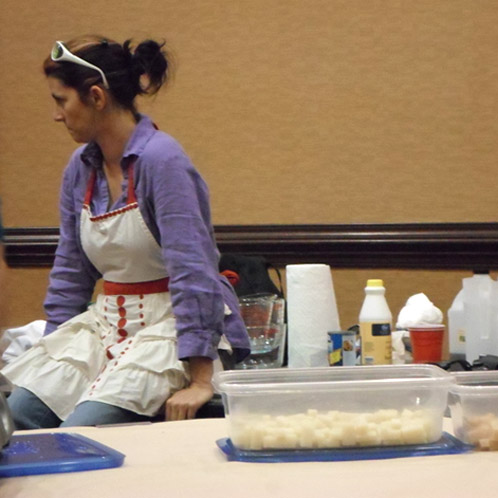
Joanna Schmidt, author of the Soap Bar Blog, hated the smell that occurred when she froze milk then added lye to the frozen milk. So she never did it again. Instead, she began using a method of incorporating milk into her soaps without adding the lye directly to the milk. She was kind enough to share her method with us. Joanna said you can use any good soap recipe for this, and I think Bramble Berry’s Lots of Lather Quick Mix would be the perfect choice!
Here’s what Joanna showed us: instead of using the full amount of water called for in your recipe, use half water and half milk, and keep them separated. Oops. Too late? Well, no use crying over spilled milk. Drink down that watery milk and let’s try again. Get yourself two containers. Weigh the milk (half the amount of water the recipe needs) in one. Weigh the water (the other half of the required water) into the other (make sure it’s a lye safe container). There. All better? It’s a good idea to put the milk back in the fridge to keep it cool.
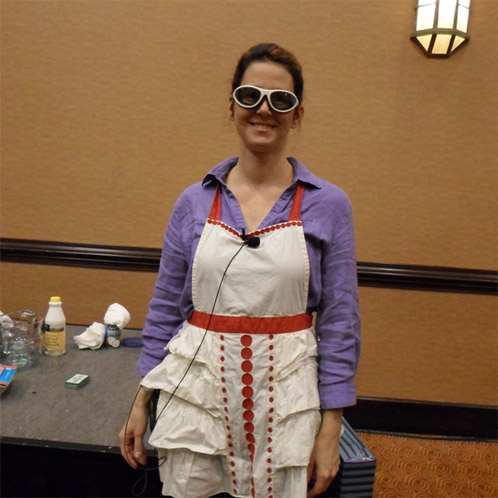
Next, suit up and be safe. (Isn’t that a cute apron that Joanna is wearing? Her daughter gave it to her!) Be sure to follow safety procedures for handling lye and working with cold process soap. Measure the full amount of lye into one container. Now add the lye to the water. Stir gently. Even though you won’t get the pungent ammonia smell you’d get if you added the lye to milk, you’ll still want to be in a well-ventilated area. Breathing in fumes as the lye and water react is not a healthy or pleasant thing. Once the lye is fully incorporated into the water, mark it as lye. Add skull and crossbones. Set it aside in a safe place where you can keep an eye on it. Next, prepare your oils. Melt any hard oils, and then add your liquid oils to them. Temperatures of the oils and the lye mixture don’t need to be exact, but they should be between 90 and 100 degrees Fahrenheit. Keeping the temperatures cool lessens the likelihood of the milk getting scorched.
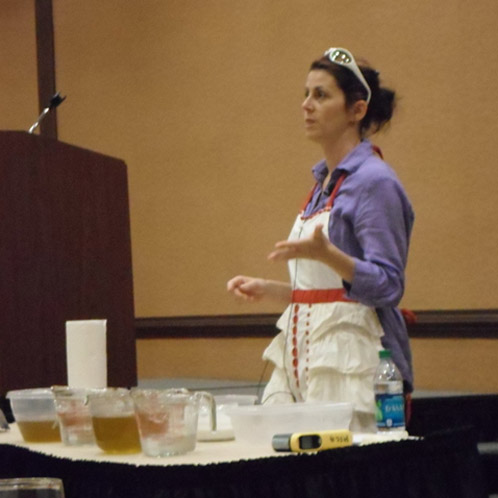
Slowly add the lye mixture to your oils. Stir it just a bit. You can even stick blend it ever so briefly. Next, add the milk. Stick blend in brief bursts until a light trace forms. Once trace forms, you can add any fragrance or essential oil you’d like to use. And you can add any other additives. Then pour the soap batter into the mold. Joanna didn’t use any additives in the presentation. That way, we got to smell just the soap, and see the color of the soap base without any added colorant.
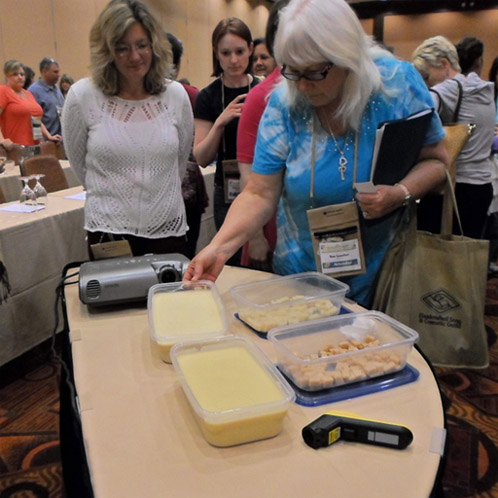
I was so engrossed in Joanna’s presentation, that I forgot to take photos of her mixing and pouring the soap. The picture above shows the beautiful soaps after they were poured. The top one is the coconut milk soap — it stayed light. The bottom one is the buttermilk soap — it darkened a bit.
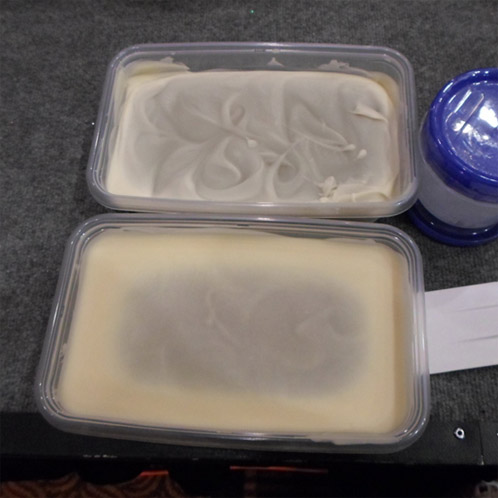
Joanna had cubes of coconut milk soap and buttermilk soap that she had made a few days before the session. The coconut milk soap is on the top, and the buttermilk soap is on the bottom. You can see an even more pronounced color difference between the two soaps in the cubes that have cured for a few days.
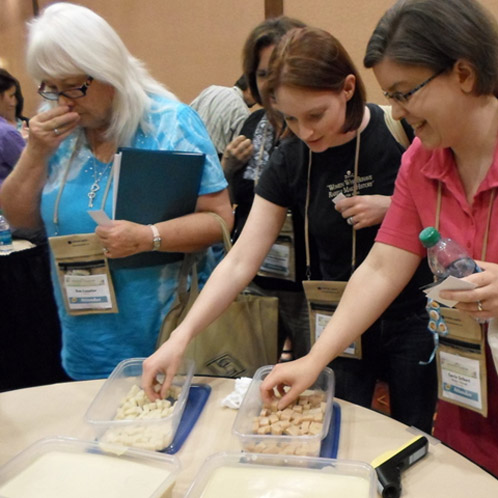
At the end of the presentation, Joanna invited us to take one soap cube of each kind. Yay! They were wonderful! Joanna told us that the buttermilk would produce a lovely lather. She also said the coconut milk one would have lots of bubbles. As soon as I got back to my room with the cubes, I tried them out.
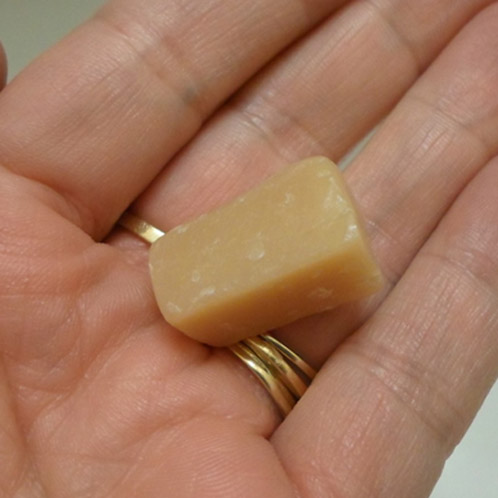
I tried the buttermilk soap first. Look at all the creamy lather!
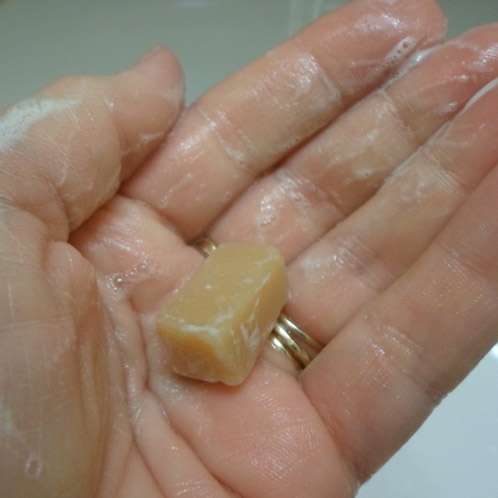
Then I tried the coconut milk soap. Look at all the bubbles!
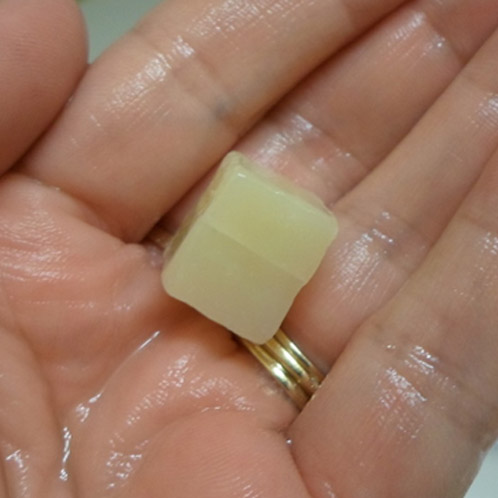
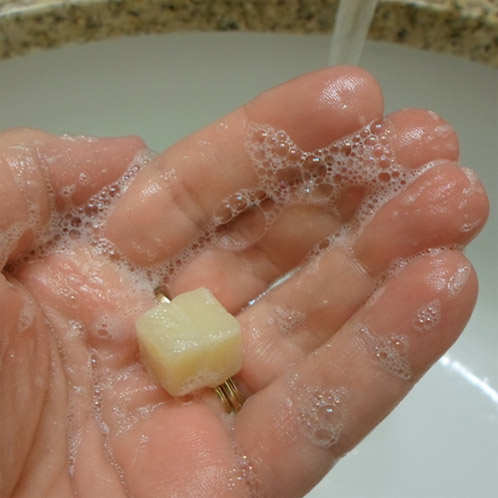
My favorite between the two was the coconut milk soap. It had bigger bubbles. I like big bubbles (and I cannot lie). Sorry. A song just popped into my head and ran out my fingers and into the keyboard 🙂 Thank you, Joanna, for a wonderful and informative session!
Interesting in learning more about milk soap? Check out Making Milk Soap from Scratch, a full color 42-page guide that will teach you 4 different techniques (inlcuding this one) for adding milk to your soap. Want even more? Try your hand at the Buttermilk Bastille Baby Bar tutorial!

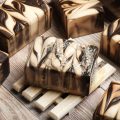
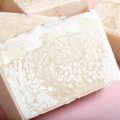

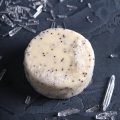
Instead of doing 1/2 water 1/2 milk, is it possible to create the lye solution with 1/4 of the water and the remaining 3/4 with the milk?
Also, for those who use 100% milk and freeze it, do you weight the milk before or after freezing? How do you freeze your milk? By 1oz cubes?
Hi Julie!
We didn’t try this method with 3/4 milk and 1/4 water, so I’m not exactly sure! I would recommend making a small test batch to see if it works for you. 🙂
Also, we typically measure out the milk before freezing it. However, some of the frozen milk can get left behind in the container, so it may help to pour a little extra just to be safe. We use ice cube trays for the milk, or our 9 Ball Silicone Molds! The Large 9 Ball Silicone Mold holds about 1.5 ounces in each cavity.
-Kelsey with Bramble Berry
Large 9 Ball Silicone Mold: https://www.brambleberry.com/Large-9-Ball-Silicone-Mold-P5533.aspx
HELP!!!!!!!!!!!!!
I have made several one-pound batches of coconut milk soap following the one-half milk and one-half coconut milk tutorial. I put them in the freezer and left them there for several hours. The second batch longer than the first. But, each batch has the ring in the middle showing they had partial gel. Should I just insulate them and let them go to gel phase. I notice the edges that didn’t gel have a great bright color and the centers are darker. What should I do? I love the creamy feel of my coconut milk soap, but don’t like the look. P.S. also tried coloring one batch, but the circle was there too. Thanks.
Good morning Barbara!
Gel can happen quite quickly in soaps, especially when you are using milk as your liquid. If you could tell me a bit more about you recipe as well as the temperatures you were soaping at, I could help troubleshoot for you. The best way to prevent the gel or circles is to immediately put your soap in the freezer as soon as you’ve poured it into the mold.
-Becky with Bramble Berry
I have had a challenging time with adding the lye to half of the water and getting it to dissolve enitrely. I make a Buttermilk and coconut milk soap and have found that the coconut milk does fine with the lye since it is not dairy. I keep the buttermilk separate and add it after the intial mix much like she explained.
Thank you for sharing this information! Shannon
Shannon – It’s nice to know that adding the lye to the coconut milk doesn’t give you problems. I am anxious to make some coconut milk soap. I haven’t given it a try yet.
Hi Shannon!
Milk soaping can be a little challenging, but after practice, you can totally get it! If you are interested in learning more about different ways you can milk soap, I’d check out this book that Anne-Marie wrote last year that I constantly refer to when I’m using milk in any of my CP recipes.
E-Book: Making Milk Soap from Scratch: https://www.brambleberry.com/E-Book-Making-Milk-Soap-from-Scratch-P5257.aspx
-Becky with Bramble Berry
This is the method I use with all my soaps. It works every time and the soap doesn’t get dark like it would if adding lye directly to milk.
Good morning, Brenda!
We are just so happy to hear that so many soapers have been using this method to create such successful milk soaps. If you get any pictures of your soaps, we’d love to see them. You can share them with us on Bramble Berry’s Facebook page. =)
https://www.facebook.com/BrambleBerry
Happy Soaping!
-Becky with Bramble Berry
So, I’m wondering after reading this who has done both coconut & buttermilk in their soap? Ive done buttermilk & have coconut milk on hand so the next time I make my fabulous OMH, I’ll use both. Thanks for the idea!
I’ve done a mixed milk bar with cow cream and goat milk. Very nice.
Hi Christine!
That sounds absolutely terrific, and I think I’m going to have to try something similar on my next milk soap batch. I also really love Ronnell’s idea of using both coconut and buttermilk in a batch. =)
-Becky with Bramble Berry
Hi Ronnell!
That sounds like such a delightful and creamy soap, and I can’t wait to hear how it turns out for you. Be sure to keep us updated on your batch. And, if you get any pictures, we’d love to see them. =) You can share them with us on Bramble Berry’s Facebook page.
https://www.facebook.com/BrambleBerry
Happy Soaping!
-Becky with Bramble Berry
I’d love to hear how the soap with a combination of milks comes out. Think of all the combinations to be tried!
…now I can’t get that rap song out of my head… nor the silly grin from my face…!!!
Nice, Nicole. Keep on rappin’ with a smile on your face. I love it 🙂
Hi Nicole!
I was the same way when I was reading this guest post too! I think I like the bubbles version much better. =)
-Becky with Bramble Berry
Great post Jean!
Thanks, Michele!
Good afternoon, Michele!
We were so lucky that Jean was able to attend the conference for Bramble Berry, and are so grateful that she was able to attend all these fun soapy classes. =)
-Becky with Bramble Berry
Do you know what accounted for the different lathers? Did she use a different recipe for coconut vs buttermilk or was it the different milk fats?
Hi, Mary! Good question. She used the same recipe for both soaps. The differences in the lather were because of the different properties the milks lend. Joanna said she loves the feel of the buttermilk soap. As I mentioned, I like big bubbles, so while both soaps were fantastic, my favorite was the more bubbly one.
Bubbly lather = Coconut milk, just like coconut oil or fractionated coconut oil makes for a bubbly lather, as does (somewhat) palm kernel oil or palm kernel flakes.
Creamy lather = any bovine milk, as well as castor oil, cocoa butter and palm oil (not to be confused with palm kernel).
And if that’s not confusing enough, castor oil also makes for nice big bubbles! A bit of castor oil should be in all formulations since it’s the only source I know of for the ricinoleic fatty acid. And it’s a conditioning oil, too. Er…think I’m off topic here. 🙂
Too funny on the rap comparison!
Hi Mary!
Like every soap recipe, the changing of ingredients (even just the milk) can change the properties of the soap (as you can see from the photos). Some people like bigger bubbles and will be more apt to go with the Coconut Soap while others like the feel of properties that the Buttermilk soap gave. If you want to learn more about milk soaping, here is a great e-book that Anne-Marie wrote all about it.
E-Book: Making Milk Soap from Scratch: https://www.brambleberry.com/E-Book-Making-Milk-Soap-from-Scratch-P5257.aspx
Happy Soaping!
-Becky with Bramble Berry
@Scherry,
How do you get double strength/fat milk? Are you just using twice the amount? Sounds interesting.
I actually use the “milk in oil” method which I found out about from Amanda of “Lovin Soap”. Rather than waiting to add the milk after the lye has already been mixed in, the milk is added to the oils before the lye solution. It has worked well for me and I did not have to worry about scorching. My milk soaps have turned out great using this method, which is great because I’ve been able to obtain fresh goat’s milk instead of canned.
So what do you mix the lye with?
Hi Janelle!
I can’t speak for Tea, but I know that some people do a half/half milk soap recipe where they cut the total liquid in half and and one half would be your milk measurement and one half would be your water measurement. You would then reserve the milk and mix the lye with the water measurement. In Amanda’s method, you actually make a lye solution with equal part lye and water, and then you add another equal part milk to the oils before you add the lye solution. I hope this helps! 🙂
-Becky with Bramble Berry
I am curious about that, too….what did you mix the lye with? Did you take a water discount?
As for your question to Sherry about the double strength milk, I don’t know if she’ll come back and answer since we don’t get any notification when replies are made, but I will take a guess and say she adds either condensed or powdered milk.
Hi Patricia!
As with a lot of recipe, Scherry might have done a half/half recipe with half distilled water and half goat’s milk. If you are interested in learning more about milk soaping, I’d check out this great book by Anne-Marie that I’ve found to be a great resource.
E-Book: Making Milk Soap from Scratch: https://www.brambleberry.com/E-Book-Making-Milk-Soap-from-Scratch-P5257.aspx
Happy Soaping!
-Becky with Bramble Berry
Hi Tea!
The milk in oil method sounds like such an interesting way to make your milk soaps and I’d love to see how they have turned out. If you have any pictures, we’d love to see them. =)
-Becky with Bramble Berry
https://www.facebook.com/BrambleBerry
To each their own! I have made milk soaps for years and never had the ammonia smell. I freeze the milk (full liquid amount), add just a tablespoon of water on top of the frozen milk to get the lye going (not absolutely necessary but it speeds things up a bit), then sprinkle the lye on top, a tiny bit at a time, stirring it with a whisk as the lye causes the milk to melt. It takes a few minutes to get all the lye sprinkled on and dissolved and all of the milk melted, but I don’t get the burned milk smell, and the soaps stay very white. Temperature never goes over about 90 degrees.
Hi Beth!
Thank you so much for sharing your technique with us, we really appreciate it. It seems like every soaper has found their own specific way of making milk soaps that work for them. If you have any pictures of your soap, we’d love to see how it turned out. You can share them with us on Bramble Berry’s Facebook page:
https://www.facebook.com/BrambleBerry
-Becky with Bramble Berry
I’m snickering at you Anne-Marie. I think of you as the happy, smiley, sweet lady who owns Brambleberry, and here you are singing yourself a soapy pun of a rap song. Well, Sir Mix-a-Lot is a local artist to you (he’s from Seattle), so I guess you’re just supporting local business! 😉
I don’t think it’s Anne-Marie, but Kristen or Amber, (silly girls!) who are filling in temporarily while A-M is on “BF Duty.”
The header says it is Jean Horn from Soap Art. 🙂
Ahhhh! I hadn’t noticed that!
Yep. It’s Jean Horn from SoapArt. I am a little silly sometimes 🙂
Hi Melissa!
We’ve totally been loving Jean’s silliness in her reports from the conference and can’t wait to hear about the rest of the weekend from her. =)
-Becky with Bramble Berry
Hi –
The only kind of soap I make is milk soap. I’ve never gotten the nasty smell noted (or burned orange color) and I don’t use water, just milk. I am wondering if it’s the lye. I like to use a high quality food grade lye.
Probably not the lye itself, but adding the lye too quickly, which heats up the milk, thus scorching the sugar in the milk causing the smell and discoloration.
I use food grade lye also, and I do get the ammonia smell!! And the orange scorching! So, learning this way to avoid the smell and scorching is wonderful!! Also……I have the batches that Joanna made at the conference here with me……NO Ammonia smell whatsoever……..This will be my new way to make my milk soaps…..what a time saver!! (I tend to not have much patience adding lye to milk cubes!!)
I am all for non stinky, more consistent creamy color with each batch!!! 🙂
Hi Tricia!
We are so glad that you were able to attend the conference and can’t wait to see your new milk soaps. If you’d like to learn more on milk soaping, here is a great book that Anne-Marie wrote a few years ago that I’ve personally found to be an invaluable resource:
https://www.brambleberry.com/E-Book-Making-Milk-Soap-from-Scratch-P5257.aspx
Happy Soaping!
-Becky with Bramble Berry
Hi Christine!
Freezing the milk is actually what helps to give your more time to work with the lye and offers a lesser chance of scorching the milk. Different methods of adding the lye and altering the temperature of the milk (i.e. freezing the milk, adding the lye slowly, keeping the milk in an ice batch, etc) work towards keeping your milk soaps creamy and unscorched. Which method do you use with your milk soaps? =)
Happy Soaping!
-Becky with Bramble Berry
https://www.facebook.com/BrambleBerry
Hi –
I freeze fresh raw milk from my goat girls less than 12 hours after it’s milked out. I measure it into ziplock bags and freeze them flat (ice cube trays sound like a lot of extra work). When I’m ready to use the milk, it gets zapped for 1 min on each side in the microwave. This makes it loose enough to “crumble” or break into smallish chunks. Then I add the lye slowly. Works great.
I do think a high quality lye contributes to a consistent end product.
Good morning, Christine!
I love hearing about your technique and I’m really glad you’ve found a way to make it work for you. Some people prefer the ice cube method as you only have to take out as much you need, but I think your way sounds really fun too! If you get any pictures of your goat milk soaps, we’d love to see them. =) You can share them with us on Bramble Berry’s Facebook page.
https://www.facebook.com/BrambleBerry
Happy Soaping!
-Becky with Bramble Berry
Christine – How wonderful that you get fresh milk from your goat girls. Thanks for sharing your process, too.
In my Goat Milk soap I actually use double strength, double fat milk with NO extra water along with the frozen milk in the ice bath method. It is a very tricky recipe I will admit. The lye “pudding” must be kept VERY cold (50-60 degrees) to avoid any type of scorch. The oils should be no more than 5 degrees up or down from the lye mixture.
The first time I added this thick mixture to my oils you could stand a spoon up in it! I almost passed out from anxiety as I worked away with spatula and stick blender but now that I have many batches under my belt it’s fairly straightforward. I designed the recipe to be able to handle the load of extra fat without sacrificing bubbles.
I did the same thing with undiluted heavy whipping cream. It was difficult but fun The problem was that I chose a very poor fragrance (fresh lemon) and the milk and lemon cured to a very sour smell. I will be trying this again however as the resulting soap was so decadent and creamy that using it was like washing in pure soapy, bubbly cream. I think a Mocha or Latte or Coffee scent would work very well. Again, the milk must be kept frigid and the undiluted heavy whipping cream was even more susceptible to scorching than the goat milk.
Happy Soaping!
Scherry C
http://www.facebook.com/aviemarebodycare
Hi Scherry!
Thanks for sharing your method of milk soaping with us. We are so happy to hear that you have found a way that works for you. Keeping it cool will definitely prevent any scorching in the soap (as you know) and give it that beautifully creamy color. Your soap sounds absolutely delightful and creamy and I can’t wait to hear more about it. Be sure to post pictures of your bath &body creations on Bramble Berry’s Facebook page. =)
Happy Soaping!
-Becky with Bramble Berry
I’m pretty certain I will be trying this immediately. I have rather hit and miss success when soaping with milks — unless they are powdered. I actually just attempted a recipe using buttermilk yesterday, and I ended up with a bunch of curdled milk floating at the top of my lye solution. Gross. (I even froze it and spent about 15 minutes slowly adding the lye to the frizen milk cubes while the container was sitting in an ice bath. It looked like I had super fine cottage cheese bobbing around on the top of scorched, orange ammonia. I shake my fist at that!) I’m glad this was posted, since this is just what I needed — alternative milk techniques! 😀
Good morning, Alisha!
I know how frustrating it can be when you can’t get your recipe to work and I hope that this technique helps your soaping out. Keep us updated and if you get any pictures be sure to share them with us on Bramble Berry’s Facebook page.
https://www.facebook.com/BrambleBerry
Happy Soaping!
-Becky with Bramble Berry
P.S. To learn more about milk soaps, here is a great book that Anne-Marie wrote a few years ago that I am constantly referring to:
E-Book: Making Milk Soap from Scratch: https://www.brambleberry.com/E-Book-Making-Milk-Soap-from-Scratch-P5257.aspx